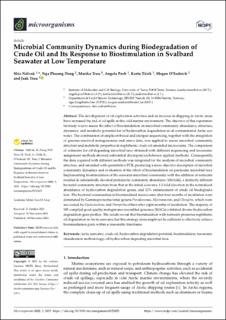| dc.contributor.author | Hiie, Nõlvak | |
| dc.contributor.author | Dang, Nga Phuong | |
| dc.contributor.author | Truu, Marika | |
| dc.contributor.author | Peeb, Angela | |
| dc.contributor.author | Tiirik, Kertu | |
| dc.contributor.author | O'Sadnick, Megan | |
| dc.contributor.author | Truu, Jaak | |
| dc.date.accessioned | 2021-11-30T08:41:38Z | |
| dc.date.available | 2021-11-30T08:41:38Z | |
| dc.date.created | 2021-11-26T11:00:04Z | |
| dc.date.issued | 2021 | |
| dc.identifier.citation | Microorganisms. 2021, 9 . | |
| dc.identifier.issn | 2076-2607 | |
| dc.identifier.uri | https://hdl.handle.net/11250/2832014 | |
| dc.description.abstract | The development of oil exploration activities and an increase in shipping in Arctic areas have increased the risk of oil spills in this cold marine environment. The objective of this experimental study was to assess the effect of biostimulation on microbial community abundance, structure,dynamics, and metabolic potential for oil hydrocarbon degradation in oil-contaminated Arctic seawater.The combination of amplicon-based and shotgun sequencing, together with the integration of genome-resolved metagenomics and omics data, was applied to assess microbial community structure and metabolic properties in naphthenic crude oil-amended microcosms. The comparison of estimates for oil-degrading microbial taxa obtained with different sequencing and taxonomic assignment methods showed substantial discrepancies between applied methods. Consequently,the data acquired with different methods was integrated for the analysis of microbial community structure, and amended with quantitative PCR, producing a more objective description of microbial community dynamics and evaluation of the effect of biostimulation on particular microbial taxa. Implementing biostimulation of the seawater microbial community with the addition of nutrients resulted in substantially elevated prokaryotic community abundance (103-fold), a distinctly different bacterial community structure from that in the initial seawater, 1.3-fold elevation in the normalized abundance of hydrocarbon degradation genes, and 12% enhancement of crude oil biodegradation.The bacterial communities in biostimulated microcosms after four months of incubation were dominated by Gammaproteobacterial genera Pseudomonas, Marinomonas, and Oleispira, which were succeeded by Cycloclasticus and Paraperlucidibaca after eight months of incubation. The majority of 195 compiled good-quality metagenome-assembled genomes (MAGs) exhibited diverse hydrocarbon degradation gene profiles. The results reveal that biostimulation with nutrients promotes naphthenic oil degradation in Arctic seawater, but this strategy alone might not be sufficient to effectively achieve bioremediation goals within a reasonable timeframe. | |
| dc.language.iso | eng | |
| dc.subject | Hydrocarbon degredation potential | |
| dc.subject | Hydrocarbon degredation potential | |
| dc.subject | Arctic seawater | |
| dc.subject | Arctic seawater | |
| dc.subject | Biostimulation | |
| dc.subject | Biostimulation | |
| dc.subject | Crude oil | |
| dc.subject | Crude oil | |
| dc.title | Microbial Community Dynamics during Biodegradation of Crude Oil and Its Response to Biostimulation in Svalbard Seawater at Low Temperature | |
| dc.type | Peer reviewed | |
| dc.type | Journal article | |
| dc.description.version | publishedVersion | |
| dc.subject.nsi | VDP::Bioteknologi: 590 | |
| dc.subject.nsi | VDP::Biotechnology: 590 | |
| dc.source.pagenumber | 24 | |
| dc.source.volume | 9 | |
| dc.source.journal | Microorganisms | |
| dc.identifier.doi | https://doi.org/10.3390/microorganisms9122425 | |
| dc.identifier.cristin | 1959623 | |
| dc.relation.project | Andre: The Estonian Research Council grant PRG548. | |
| dc.relation.project | EU – Horisont Europa (EC/HEU): 679266 | |
| cristin.ispublished | true | |
| cristin.fulltext | original | |
| cristin.qualitycode | 1 | |
